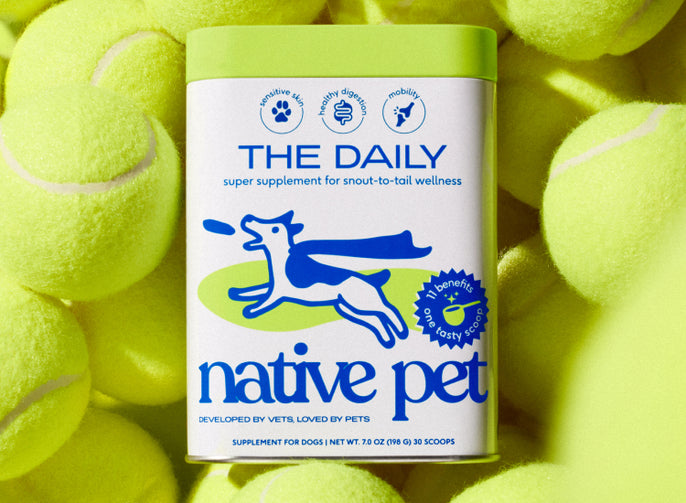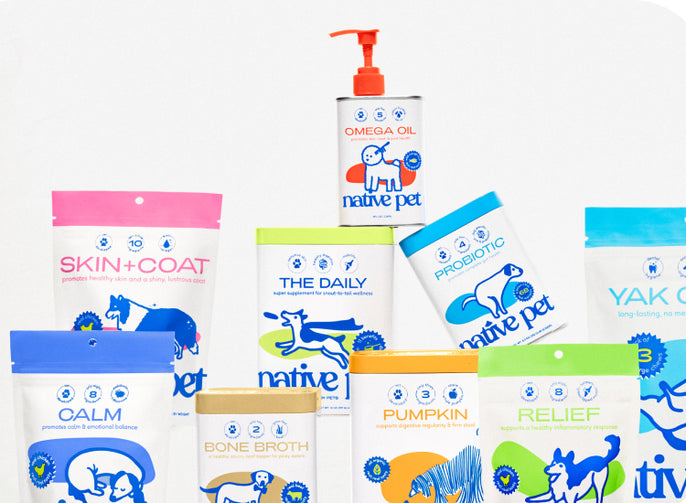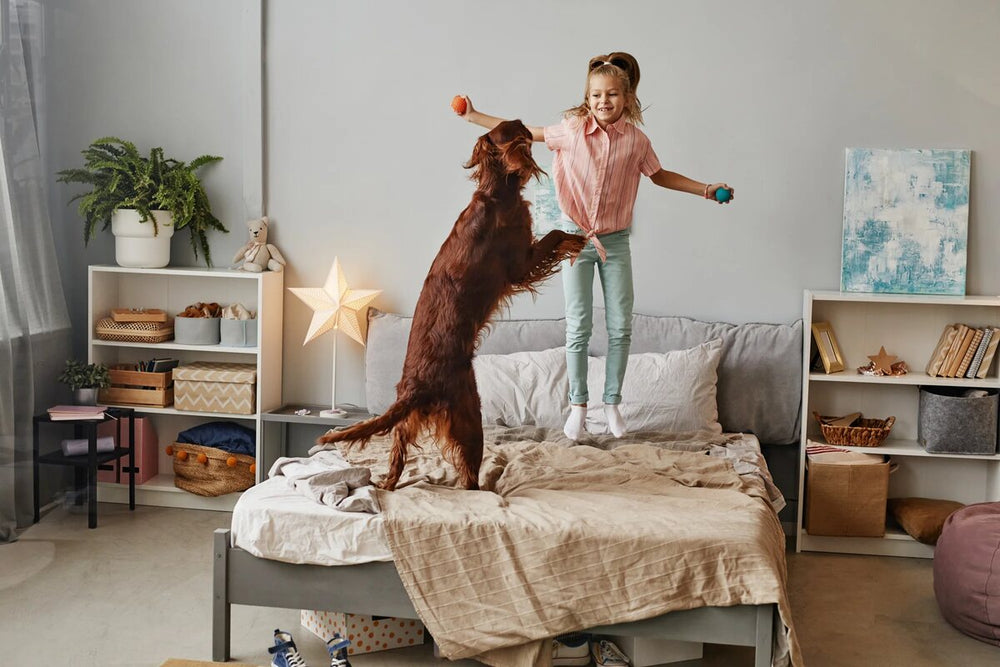By: Sara Ondrako, Certified Canine Behavior Consultant
My first dog as an adult was the cutest little pogo stick you ever did meet. That was my endearing phrase to mean he was bonkers. High energy. Hyperactive. He was a Miniature Pinscher that, for the first six years of his life, seemed to lack the ability to walk but rather, only knew how to run or bounce (like a pogo stick) to get from place to place. Every day was the best day ever, and it was quite comical to watch my dog do everything with so much enthusiasm. He constantly sought my attention in ways that a college kid did not have the patience or experience to handle appropriately. I chalked it up to him just being a hyperactive breed because that’s what the “experts” at the pet store he came from had told me. Practically a kid, I knew no better.
Hyper means “unusually energetic” and the first thing to know about unusually energetic dogs is that they are typically hyper due to a need not being met. There’s always a root cause and just being considered an “energetic breed” does not mean a dog’s hyperactive behavior is normal. There are breeds that generally require more physical activity and mental stimulation, such as herding breeds like Australian Shepherds, German Shepherds, and Border Collies. There are also breeds that typically cannot be exposed to a lot of physical activity for genetic reasons, such as French Bulldogs and Pugs, who are more prone to heat stroke and respiratory problems. Despite breed generalities, you’ll find the most success by looking at the individual dog in front of you to truly address hyperactivity (or any behavioral concern). Dogs, like humans, are a product of both their genetics and their environment.

For new puppy owners out there, keep in mind it is normal for puppies to be more high-energy than adult dogs. So if you’re feeling exhausted from keeping up with your puppy’s activity level - you’re probably doing it right! I recommend every puppy owner, experienced or not, recruit a reputable dog trainer that practices Least Invasive Minimally Aversive techniques (LIMA) to navigate the puppy phase. They can help pinpoint practical solutions if your puppy has a lot of energy to avoid turning into a hyperactive dog.
Those evening zoomies, repetitive behaviors, and “redecorating the room” episodes can be extremely frustrating. Here are five common causes and solutions to help you calm your dog down:
Reason One: Not enough movement in their day
-
This is especially the case for dogs that end up in their kennel for 10 hours a day due to long work hours or for dogs without much routine or structure from a human working from home.
Here’s what to do: Increasing physical exercise that includes the brain can actually help calm a dog. Try tackling playground equipment with your dog and walking around things in different patterns rather than a straight line to move their paws in ways that will require the brain to participate. Look into agility equipment or canine fitness equipment (which I love for apartment living). Don’t rely on a fenced yard to provide a suitable physical outlet for a high-energy dog and avoid trying to wear them out by relying on repetitive activities such as fetching for 30 minutes straight. Without inducing thought, these activities simply build physical stamina, which can sometimes induce obsessive behaviors. If you are rushed for the day or work long hours, increase their enrichment at feeding time and consider hiring a dog walker to help.

Reason Two: Attention-Seeking
-
If your dog has bursts of fast movements such as a catapulting off the couch and crashing into the coffee table where your fresh cup of joe and croissant neatly sit, they may be trying to tell you they need more one-on-one time. Humans need quality time to cultivate relationships, and your furry best friend is no different. Those sudden bursts of energy (especially if they result in the loss of that tasty croissant or cracking your favorite coffee mug) are sure to get your attention, even if that attention is you yelling a few explicatives as a result of the aftermath.
Here’s what to do: Increase your quality time and reward them for calm behavior. Domesticated dogs were bred to be dependent, so schedule more playtime with your pooch and consider letting them co-pilot on your errand run. Instead of curling up in a chair to read, toss a pillow on the floor and invite them to sit next to you.
Carry a treat pouch with some of your dog’s kibble from breakfast and/or mixed dog treats to mark and reward calm dog behavior he/she exhibits in real-time. If your dog sits in front of you for affection, rather than jumping on you, match their calm energy, and give them a treat to tell them you like that behavior.

Reason Three: Underlying anxiety
-
In simple terms, dogs with anxiety have a perception that something scary will happen. Some dogs are genetically prone, but the disorder is heavily influenced by what a dog is or is not exposed to as a young puppy during their critical socialization periods. There are many signs and symptoms of anxiety; however, one quick test is seeing if your dog can offer you - and hold - eye contact easily, or are they breaking eye contact to constantly watch or listen for what’s around them?
Here’s what to do: talk to a certified behavior consultant - They are trained to read your dog’s body language, determine potential causes, know how to make the situation better, and can suggest when it may be time to involve a veterinarian or a board-certified veterinary behaviorist. A dog’s anxiety is personal to them and may not make sense to you. A behavior professional can help shed light on the reality your dog is experiencing.
Below are some examples of tools and techniques they may use to help your anxious dog calm down during behavior modification. While you can implement some of these on your own, you will get much farther by involving a professional with extensive experience, especially if you are dealing with a more complicated issue such as separation anxiety.
-
Aromatherapy sprays or diffusers - scents such as lavender and chamomile as well as Maternal Appeasing Pheromones have been shown to help promote relaxation.
-
Sniffaris - dogs experience the world through their noses and sniffaris are nose-exploration games to shift focus from fear to fun. Sniffaris are great confidence boosters that provide much-needed mental stimulation.
-
Muffling/Calming Sounds - while many turns to white noise, newer observations indicate that sounds such as brown noise, pink noise, or curated classical music like Through A Dog’s Ear may be more effective. Utilizing these sounds during thunderstorms with a thundershirt a snuggling with your dogs in a safe place can help to reduce stress levels.
-
Ear massage - dogs’ ears have sensitive nerve endings that, when gently rubbed, help release happy hormones throughout the body and can have a calming effect.
-
Calmer Canine Loop - a device that works with electromagnetic waves and directly targets your dog’s brain to reduce anxiety.
-
Environmental management - Preventing your dog from being exposed to triggers or situations that can increase stress, for example, providing a visual barrier on windows or removing them from areas where loud noises are present such as construction or fireworks.
- Calming Supplements such as CBD oil, or anxiety medication - while many are available over the counter, be careful about taking medical advice from anyone that doesn’t have a DVM or VMD behind their name (a veterinarian) - it’s great to share but ask your vet if it is safe for your dog first. One of my favorite go-tos is the Native Pet Calm Chews. They are naturally derived ingredients that are limited - so no extra junk that could exacerbate other underlying conditions. These Calming Chews contain melatonin, so I use them for rest periods to help ensure recovery-driven sleep to support a well-balanced brain.

Reason Four: Impulsivity
-
Dogs that lack impulse control are simply reacting to their environment with little to no thought. As a person, you know knee-jerk responses can have detrimental consequences. Think of impulsivity as your dog’s knee-jerk response. Impulsivity is often driven by high arousal, meaning a high energy state. What may look like just an energetic dog on the surface may actually be a dog with an underlying impulse control issue.
Here’s What to Do: Practice impulse control exercises with your dog and tap into those amazing brains through training with appropriate activities. Dog training builds the bond between pet parents and pets and cultivates the habit of thoughtful decision-making - the opposite of impulsivity. Obedience (your dog listening when you ask them to) is an excellent byproduct of training your dog, but the bigger benefits are the result of a well-balanced brain and good doggie manners. For dog breeds that are typically more active dogs like Labrador Retrievers or Chesapeake Bay Retrievers, participating in dog sports such as dock diving or field trials are great ways to train with your dog naturally and burn off excess energy. Nose work is another fun sport for all of you Beagle and Hound lovers out there. If you have a dog like a Siberian Husky, don’t fret if you lack access to sleds to pull or mushing experience. You can emulate sporting by grabbing hiking vests or backpacks for dogs, filling the weight bottles, and popping them on your pups for a walk to increase the physical and mental challenge.
Reason Five: Stress in the home
-
Stress in the home from conflict or a pet parent that personally suffers from anxiety. Our dogs were bred to tune into us emotionally, which is why they make wonderful service animals. If their person is experiencing high levels of stress in the home, they are going to feel stress as well. If someone doesn’t treat them well (yells, hits, or otherwise punishes them), they will take that stress to heart, and as that negative energy compounds, they will often display bouts of hyperactivity as an outlet to try and alleviate that energy however they can.
Here’s What to Do: Check your own energy and stress level. Practice mindful breathing or box breathing to help slow your heart rate and respiration rate when you are with your dog if you are feeling stressed. Spend a few extra moments petting your dog; research shows this can decrease blood pressure, decrease cortisol (stress hormone) in the blood, and release oxytocin, a feel-good happy hormone. Get help for yourself if you are in a stressful home environment, whether that be through therapy, environmental management, or even doing a time-management assessment. Exuding stress begets stress, and exuding calm begets calm. Work on modeling your home to be a safe place for both you and your dog to decompress and relax.

Additional tips to promote calm behavior:
-
If your dog has medical conditions that require restricted physical activity such as heartworm treatment or orthopedic surgery, increase their mental enrichment by placing their dog food in puzzle toys and teaching relaxation exercises so that your dog feels calm and not frustrated by the restrictions.
-
Avoid areas with a lot of stimuli if you have an anxious dog, such as dog parks, breweries, or even play dates with another high-energy dog. Aim for open parks, hikes to give space from other animals or people, and playdates with dogs that are not only confident but match your dog’s activity level and promote stable play for socialization.
-
If high energy levels are a concern, opt to adopt older dogs instead of puppies. Most older dogs have settled out of the puppy wiggles. You may want to consider a washout service dog or perhaps a 4-year-old brindle mutt whose foster pawrents describe him as a Netflix and chill kind of guy.
- Do your breed research before adopting, and if purchasing, be sure it’s a reputable breeder. This can help you avoid the high-maintenance Jack Russell Terrier just because he’s super cute and can also mean the difference between a solid dog and a solid mess. You can find a quick rundown of many temperaments and traits of various breeds on the American Kennel Club Website (AKC). Avoid succumbing to “fad dogs” such as the Dalmation when 101 Dalmations came out and, more recently, Channing Tatum’s sidekick in the movie Dog. Most dog owners do not need a Belgian Malinois in their life - trust me on this one.
Remember to look at the individual dog’s needs to determine if they are being met, not just the breed. I’ve met Golden Retrievers that are wonderfully calm and collected therapy dogs, and I’ve met Golden Retrievers that are hyper-hot messes. I promise you the difference between those dogs cannot be accounted for by looking at their genetics alone, but rather their mental and physical well-being as driving forces behind their behavior.
As for me and my little pogo stick, even as a poorly-equipped college kid, I learned so much about the importance of individual needs when living with a “hyper dog.” I was eventually able to channel all of that fantastic energy into a brilliant, friendly dog that could relax when it was downtime and even snuggle in for snoozes like a cuddle master. It only took me six years.


